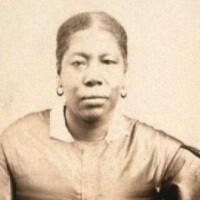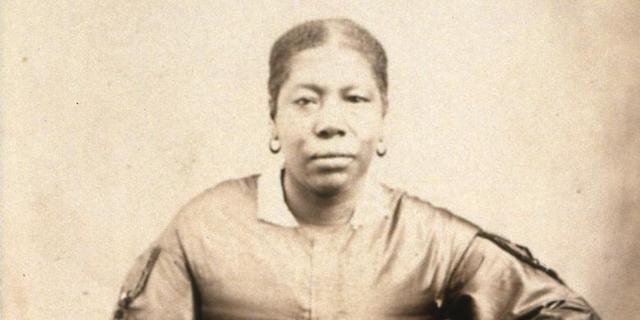Born on September 22, 1822, in Wilton, Fairfield County, Connecticut—the daughter of former slaves Isaac and Fillis Manning—Jane Elizabeth Manning was baptized in 1842 into The Church of Jesus Christ of Latter-day Saints, which brought her great reproach. This was the beginning of many trials for Jane as a convert of African descent. Denied passage on the ship that was to transport her family from Buffalo, New York, the Mannings (including Jane, her mother, several siblings, and two in-laws) braved the elements to walk the entire distance to Nauvoo, Illinois. Once they arrived, they encountered much “rebuff” in the city that Jane described as “our destined haven of rest.” The rebuff ended, however, as soon as they found the home of Joseph and Emma Smith. There, they were welcomed warmly. Joseph told them they were “among friends.” Eventually, Jane became a household servant to the Smiths and was even invited to be adopted to them as their child, an invitation she declined.1
After the deaths of Joseph and Hyrum Smith, all the Mannings but Jane remained either in Illinois or Iowa. Jane married Isaac James, and the two of them migrated with the Saints to the Salt Lake Valley with Jane’s son, Sylvester, born before Jane’s conversion to the Church. Jane gave birth to another son, Silas, during the journey and a daughter, Mary Ann, soon after their arrival. . . .
► You’ll also like: “I had seen him in a vision”: Jane Manning's remarkable and touching interactions with Joseph Smith
In Jane’s details about life in Utah, she listed even more challenges and once more rejoiced that God had supported her through them:
"My husband Isaac James worked for Brother Brigham, and we got along splendid accumulating Horses, cows, oxen, sheep, and chickens in abundance. I spun all the cloth for my family clothing for a year or two, and we were in a prosperous condition, until the grasshoppers and crickets came along carrying destruction wherever they went, laying our crops to the ground, strip[p]ing the trees of all their leaves and fruit, bringing poverty and desolation throughout this beautiful valley. It was not then as it is now. There were no trains running bringing fruits and vegetables from California or any other place. All our importing and exporting was done by the slow process of ox teams. "Oh how I suffered of cold and hunger and the keenest of all was to hear my little ones crying for bread, and I had none to give them; but in all the Lord was with us and gave us grace and faith to stand it all."26
In 1870, Isaac James and Jane divorced, and Isaac left Utah for parts unknown. Jane had a brief two-year marriage with a former slave, Frank Perkins, but soon resumed life as a single parent and grandparent. Then, after a twenty-year absence, Isaac, now very ill, returned to Utah. Though the two did not remarry, Jane cared for her former husband in his sickness, and his funeral was held at her home. She does not acknowledge the divorce in her history, but she does talk about Isaac and the loss of all her children but two, yet again she gives praise to God: “I am a widow, my husband Isaac James died in November 1891.27 I have seen my husband and all of my children but two, Laid away in the silent tomb. But the Lord protects me and takes good care of me, in my helpless condition.”28
Jane was ultimately bolstered by the relocation of her brother, Isaac Lewis Manning, to Utah in the early 1890s.29 Though he had joined the Reorganized Church in Iowa, he was soon rebaptized in Utah and became his sister’s constant companion, which she mentions gratefully in her life story: “I live in my little home with my brother Isaac, who is good to me. We are the last two of my mothers family.”30
Jane’s history might seem typical of other pioneers’ in some ways, but because of her African lineage, she was not allowed some of the privileges that white Latter-day Saints had, the most significant being receiving temple ordinances. Some of Jane’s most poignant words are in letters she dictated and either mailed or hand carried to Church leaders. In these letters, Jane boldly petitioned to receive the endowment. Though she understood that policy at the time would deny her entrance to the temple because of her race,31 she showed remarkable theological sophistication as she reminded her letters’ recipients of the Abrahamic covenant.
Her first letter, dated December 27, 1884, was directed to Church president John Taylor. It read in part:
"Dear Brother "I cauled at your house last thursday to have conversation with you concerning my future salvation. I did not explain my feelings or wishes to you. I realize my race & color & cant expect my Endowments as others who are white. My race was handed down through the flood & God promised Abraham that in his seed all the nations of the earth should be blest & as this is the fullness of all dispensations is there no blessing for me?"32
She subsequently implored not only President Taylor but also President Wilford Woodruff and Relief Society general president Zina D. H. Young for the privilege of entering the temple. After she received a recommend to do baptisms for the dead, she wrote a moving letter to the man who would preside over the Church at the time of her death, Joseph F. Smith, requesting more than she had been given. To him she wrote on February 7, 1890:
"Dear Brother "Please excuse me taking the Liberty of Writing to you—but be a Brother—I am anxious for My Welfare for the future . . .—and has i hope to be one, Bye and Bye, bearing the same name as yourself—I was requested to write to you—Hoping you will please show kindness to me. . . . ". . . Can i obtain Endowments for my Dead? Also, I had the privilige of being babtised for My Dead, in October Last. . . . Can i also be adopted in Brother Joseph Smiths the prophet[’s] family, I think you are somewhat Acquainted with me—I Lived in the prophets family With Emma and others, about a year—and Emma Said Joseph told her to tell me—I could be adopted In their family, she asked me if i should Like to. I Did not understand the Law of adoption then—but Understanding it now. Can that be Accomplished and When— "I have heard you attend to the prophets Business in those matters—And so have Written to you for information."33
Jane was not allowed to receive her endowment and was eventually sealed to Joseph Smith as a servant, not as a child. Nonetheless, she referred to her temple experiences with reverence and hope:
"I have lived right here in Salt Lake City for fifty two years, and I have had the privelege of going into the Temple and being baptized for some of my dead. "I am now over eighty years old and I am nearly blind which is a great trial to me. It is the greatest trial I have ever been called upon to bear, but I hope my eysight will be spared to me poor as it is, that I may be able to go to meeting, and to the temple to do more work for my dead."34
On April 16, 1908, Jane Elizabeth Manning James passed away. As she had requested, her life story was read at her funeral, which was attended by many Church leaders, including President Joseph F. Smith. Jane’s story concludes with her testimony:
"And I want to say right here, that my faith in the gospel of Jesus Christ as taught by the Church of Jesus Christ of Latter-day Saints, is as strong today, nay, it is if possible stronger than it was the day I was first baptized. I pay my tithes and offerings, keep the word of wisdom, I go to bed early and rise early, I try in my feeble way to set a good example to all."35
Though she herself would not recognize it, Jane’s example has nothing feeble in it. It serves as one of the strongest and most thoroughly proved of any in Latter-day Saint history.
Lead image from ChurchofJesusChrist.org.
Learn more about Jane's powerful relationship with Joseph and Emma Smith in Jane and Emma.
This acclaimed film is based on the historical record of the friendship between Jane Manning, one of the first black members of the Church, and Emma Smith, wife of the Prophet Joseph. Told in the wake of Joseph Smith's assassination,Jane and Emmaexplores the profound relationship between these two great women and the strength and unity they find together during troubling times.
And learn more about the remarkable women who have shaped our Church in Women of Faith.
This groundbreaking series recounts the lives of women of faith and dedication in The Church of Jesus Christ of Latter-day Saints. Often in their own words, they share their trials, triumphs, and testimonies.
This fourth volume features women born between 1872 and 1900 whose stories explore a comparatively untapped era in Mormon history. This generation of Latter-day Saint women experienced firsthand the challenges of the Mexican Revolution, World War I, and World War II. They also witnessed the unprecedented global expansion of the Church and the first young women to serve as proselytizing missionaries.
^ Jane Manning James Autobiography, 1893 [ca. 1902], dictated to Elizabeth J. D. Roundy, Holograph, pp. 17, 20, Church History Library, The Church of Jesus Christ of Latter-day Saints, Salt Lake City, Utah, hereafter cited as Church History Library.
^ James, Autobiography, 21.
^ James died on November 19, 1891, at age seventy-three. “Isaac James,” Utah, Salt Lake County Death Records, 1908–1949, FamilySearch, The Church of Jesus Christ of Latter-day Saints, accessed April 20, 2012, http://familysearch.org.
^ James, Autobiography, 22.
^ Wolfinger, “Test of Faith,” 139.
^ James, Autobiography, 22.
^ The policy was changed with the 1978 revelation on priesthood received by Church president Spencer W. Kimball. Edward L. Kimball, “Spencer W. Kimball and the Revelation on Priesthood,” BYU Studies 47, no. 2 (2008): 4–78.
^ Jane E. James to John Taylor, December 27, 1884, quoted in Wolfinger, “Test of Faith,” 148. Original located in the John Taylor Collection, Church History Library.
^ Jane E. James to Joseph F. Smith, February 7, 1890, quoted in Wolfinger, “Test of Faith,” 149. Original located in Joseph F. Smith Papers, Church History Library.
^ James, Autobiography, 22. For information about Jane’s sealing to Joseph Smith, see Salt Lake Temple, Adoptions and Sealings: living and dead, 1893–1961, Book A, May 18, 1894, p.26; Devery S. Anderson, ed, The Development of LDS Temple Worship, 1846–2000: A Documentary History (Salt Lake City, UT: Signature Books, 2011), 97–98; Newell G. Bringhurst, “The ‘Missouri Thesis’ Revisited: Early Mormonism, Slavery, and the Status of Black People,” in Black and Mormon, ed. Newell G. Bringhurst and Darron T. Smith (Champaign: University of Illinois Press, 2006), 23–24.
^ James, Autobiography, 22.


